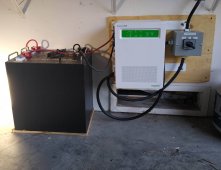I have an older 10KW grid-tied system with 48 Enphase M215 micro-inverters. I want to set up a relatively inexpensive battery backup with two 48V x 100A rack batteries. In order to tie to my household wiring I'd need both phases of 240V, and the SW4048 seems to be the only reasonably priced inverter I can find which meets UL1741, and does two-phase. I have a series of questions
- The vendor says it can't work in a grid-tie environment, but the literature says it can. Have you any sage advice?
- The vendor says I absolutely need the battery controller, the battery monitor and the Distribution Panel (and the smart home controller) - the vendor says the system won't work without these. Is that correct?
- All inverter/chargers have separate AC input and AC outputs. What I want is for these to be the same, i.e. AC is wired from the main panel to the inverter's AC input to charge batteries until the grid dies, then AC is produced by the inverter (from the batteries) and fed to the main panel. I isn't practical in my application to isolate critical loads to a sub-panel "downstream" of the inverter. Has anyone accomplished this, perhaps using a manual or auto transfer switch, and if so how have you wired it?
- I'd like to be able to charge batteries and run the house on solar during a power outage. UL1761 seems to allow that, as long as there is adequate demand to absorb the energy produced by the panels/M215 inverters. Is this an unrealistic hope, or would the frequency-shift of the SW4048 accommodate this?
- If I'm totally barking up the wrong tree here, and I can't rely on an automated hybrid inverter to do all that I want, is it reasonable to simply do a battery backup which I manually switch over using a less sophisticated inverter/charger - perhaps like the SungoldPower "6000W DC 48V Split Phase Pure sign wave inverter with charger & UL1741" - and if I do, is there any hope that the UL1741 on this device will allow me to use my solar during an outage.



